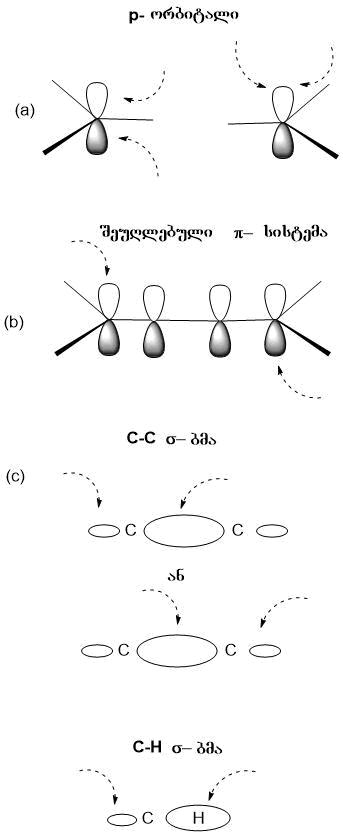ქიმიის ტერმინთა განმარტებითი ლექსიკონი
- ინგლისურ-ქართული
- ქართულ-ინგლისური
- ლექსიკონის შესახებ
- გამოხმაურება

| antarafacial | ანტარაფაციალური |
| When a part of a molecule ("molecular fragment") undergoes two changes in bonding (bond-making or bond-breaking), either to a common centre or to two related centres, external to itself, these bonding changes may be related in one of two spatially different ways. These are designated as "antarafacial" if opposite faces of the molecular fragment are involved, and "suprafacial" if both changes occur at the same face. The concept of "face" is clear from the diagrams in the cases of planar (or approximately planar) frameworks with isolated or interacting p-orbitals [diagrams (a) and (b)].
|
როდესაც მოლეკულის ნაწილი („მოლეკულური ფრაგმენტი“) საერთო ან ორ გარე ცენტრთან დამაკავშირებელ ბმაში ორ ცვლილებას განიცდის (ბმის წარმოქმნა ან გაწყვეტა), ეს ცვლილებები შეიძლება დაკავშირებული იყოს ორი განსხვავებული სივრცითი გზით. ისინი აღინიშნება როგორც "ანტარაფაციალური", თუ მოლეკულური ფრაგმენტის საპირისპირო ზედაპირებია ჩართული, და "სუპრაფაციალური", თუ ორივე ცვლილება ხდება ერთსა და იმავე ზედაპირზე. ეს ცნებები ნათლად ჩანს სქემებიდან ბრტყელი (ან თითქმის ბრტყელი) ჩარჩოების შემთხვევაში იზოლირებული ან ურთიერთქმოქმედი p-ორბიტალებით [დიაგრამები (a) და (b)].
|
| See also: anti | ასევე იხილეთ: ანტი |
| Source | წყარო: PAC, 1994, 66, 1077 (Glossary of terms used in physical organic chemistry (IUPAC Recommendations 1994)) on page 1084 |
|










